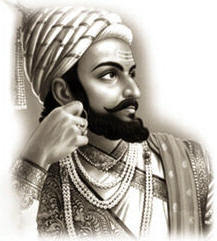“Shivaji.” Maratha general and leader. Sivaji was a lifelong opponent of Muslim power in Western India in general, and a military and political opponent of the Mughal Empire, specifically. He saw his first fighting at age 19. Sivaji developed sophisticated concepts of the style of warfare that from the early 19th century would be called “guerrilla warfare,” but such tactics were better known in this era as guerre guerroyante, or raids and ambushes. As the leader of a small group of Hindu rebels, he conducted several guerrilla campaigns against the Muslim sultanate of Bijapur, slowly expanding Maratha territory with repeated local victories. This provoked the sultan to send over 20,000 troops against Sivaji and his Maratha band in 1657. Sivaji retreated into the highlands of the Deccan while pretending to offer to negotiate with the Bijapur general, Afzal Khan, who had been sent to rout him out. When Khan agreed to parley, Sivaji sprang a trap and had him assassinated. Leaderless, the Bijapuri army was quickly defeated by Marathas and thousands of new recruits who poured out of the mountains to fight for Shivaji at Pratapgarh (November 30, 1659), and again at Kolhapur (December 28, 1659).
In the wake of these sharp victories, Sivaji’s cavalry overran additional territories. In 1664, he sacked the Mughal port city of Surat, which provoked a powerful Mughal assault on his home territories the next year. Emperor Aurangzeb began to pay more attention to events in the Deccan. He sent several armies against the charismatic Sivaji, whose movement was threatening to provoke a more general Hindu revolt against Mughal overlordship. Failure to combine approaching Mughal forces into a single strike was a major operational mistake that allowed Sivaji to defeat each detached army in detail.
For several years, Shivaji fought losing defensive campaigns against the Mughals; Aurangzeb had sent a concentrated Mughal force at least 100,000 strong to deal with the Marathas. This was too much force even for Sivaji, who finally submitted to Mughal force majeure. Brought before Aurangzeb’s peripatetic court, Sivaji was compelled to bend the knee in a humiliating act of submission- which saved his life. While under house arrest in Agra, in 1666, Sivaji plotted escape and vengeance. He accomplished the first feat by sending out basins of sweets as alms for the poor, and then disguising himself as a bearer and leaving with the last delivery. Another version of what became a legendary tale of a Hindu hero is that Sivaji was smuggled out inside one of the basins of sweets. In either case, he spent the next years seeking a diplomatic settlement with Aurangzeb, rather than continuing to fight against overwhelming Muslim power. Lulled into a false sense of military superiority, the Mughal court agreed to recognize Sivaji as a local leader in a much-reduced Maratha state, and turned its attention elsewhere. That was another mistake.
Early in 1670, Sivaji, who had been secretly gathering strength, suddenly attacked several isolated Mughal garrisons in Maharashtra. By the end of the year, he retook virtually all territory he held previously. As Hindus rallied to his banner, the Maratha army grew by many tens of thousands, though its main strength remained its cavalry arm. For the next four years, Sivaji harassed Mughal garrisons, cut off forts, captured new territories, and drove back the frontier at Aurangzeb’s expense, and to his lasting humiliation. In 1674, Shivaji proclaimed himself king of an independent Maratha state. This was no idle boast: the warrior state Shivaji constructed in the highly defensible highlands of the arid Deccan, along with a careful regional alliance system set up with smaller Muslim states that also feared domination by the Mughals, enabled Maharashtra to be the dominant power in central India for the next 100 years.
